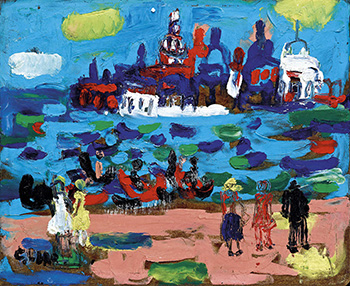PROVENANCE:
Collection of Ms. Wang, Taiwan (acquired directly from the artist)
Ravenel 2012 Autumn Auction, Taipei, lot 652
ILLUSTRATED:
Centurial Rairity: Complete Works of Liao Chi-chun , Ever Harvest Art Gallery, Taipei, January 2017, color illustrated, p. 467
Catalogue Note:
VENICE
LIAO CHI-CHUN
Liao Chi–chun’s artworks can be roughly divided into three phases. The works in the early phase were influenced by Japanese Pleinarisme. With exaggerated designs and muted colors the general feeling is often subdued. The style is similar to Post– Impressionism where the sense of self is emphasized and there is a touch of college–flair and country– flavor. The works from the middle phase are usually semi–abstract with gradually brighter colors. He also favored the sharp contrast between pink and light green or light blue in the fauvist style. In 1962 he was invited by the US State Department to continue his studies in art, and as a result of touring major galleries and museums, his horizon expanded and his style gradually changed. Liao was influenced by French Post–Impressionism, Fauvism, abstract art, and Americanism causing his style to become more independent and mature. His late phase was the zenith of his work. The artworks are semi– representational and semi–abstract. They usually depict local Taiwanese areas, with vivid colors and flowing brush–strokes that show the perfect harmony between art and life. The carefree, bright colors are still praised in the Taiwanese art world.
Liao Chi–chun delighted in portraying mountains and water, especially the scenery of rivers and harbors. His works in depicting water scenery began in the 1950s with his Tamsui sketches. In the 1960s, returning home from America and Europe, his experiences and perspectives were greatly expanded. American abstract painting and the sophistication of Europe astounded Liao and his artworks reached the summit of their creativity from 1960–1970. After having experienced the splendor of Venice with the lively bustle of gondolas darting around in the canals, the creative atmosphere of freedom and harmony allowed him to transform all his experiences into a creative drive after his return to Taiwan and forge his own path. Whether it is Tamsui, Love River, Venice, Yehliu or his life’s last stop, Donggang, under Liao’s paintbrush, these locations renowned for their water scenery all depict a familiar vivacity and exuberance.
In the work of “Venice” that was painted in 1963, explicitly demonstrated a strong Fauvist influences, with a free flow of colors and rigorous compositions, despite the use of bold colors, the painting is well balanced and is a showcase of the conficence of expression. Liao Chi- Chun had travelled to Europe in the late 50s and the wonderful memory of that was elevated with personal emotions which are later transferred onto canvases. In the work of “Venice”, not only can we see the use of imaginative cyan depicted as the gleaming reflection of waves, boats that flow and swing with the waves, but also seeing romantic pink brushes as the pavement by the riverside. With light yellow up front and outstanding use of white in the back, this creates a sense of spatial conversation. This painting is an excellent work of the 60s, as demonstrated through the sophisticated use of brush strokes and delicate depiction of subtle changes of light.
